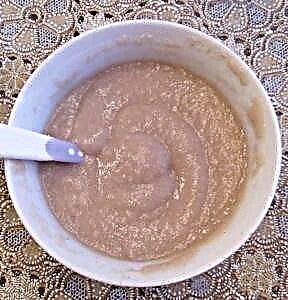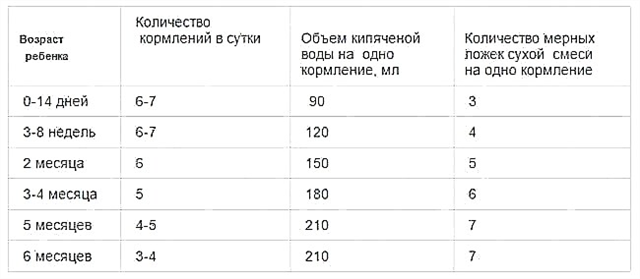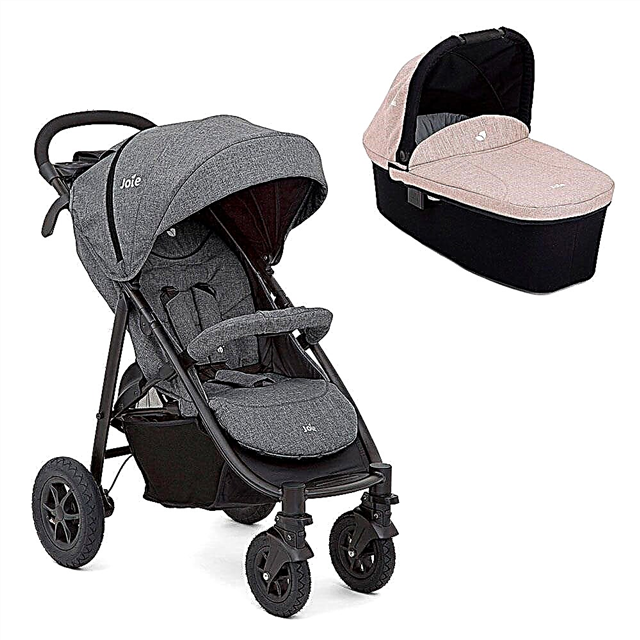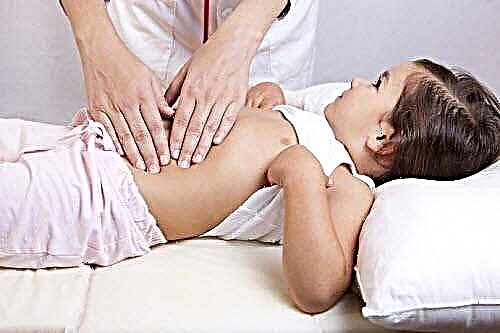The rules for introducing solid food into the baby's diet are simple. The most important thing is to understand them and find the right time to introduce it. If you are breastfeeding your baby and he is gaining weight well, introduce complementary foods no earlier than six months. Until that time, breast milk satisfies all the needs of the baby. But not all babies are fed with mother's milk. If you are giving your baby formula, you can start the cereal complementary foods a little earlier. In any case, do not try to give your baby porridge before 4.5 months, because the digestive enzymes are not quite ready for new foods yet.
When to inject porridge?
The best time to start feeding your baby with porridge is 5 months or later.
 At this age, the child is already able to digest the nutrients contained in cereals. If you introduce porridge too early, your baby is at high risk of bowel problems.
At this age, the child is already able to digest the nutrients contained in cereals. If you introduce porridge too early, your baby is at high risk of bowel problems.
If parents take a few minutes to browse the children's section at the local supermarket, they will be able to see a huge range of products, including cereals. Supermarket shelves are filled with baby food that claims to be the best, very nutritious, healthy, and so on - because that's what all parents want for their baby.
Porridge is an important and necessary element in the children's diet. Many pediatricians recommend this type of nutrition to start complementary foods. Porridge, enriched with vitamins and trace elements, should certainly form the basis of an infant's menu, since its use has a positive effect on the intestines. Baby cereals for the first complementary foods can be made independently at home or bought ready-made in packages. Parents need to know when to introduce porridge to the baby and how to avoid problems.
How to introduce porridge?
If you think that the child is ready and the pediatrician also gives the green light, here a few tips for introducing porridge:
- Start giving porridge once a day, in the morning. This is the time when the baby is hungry and well rested. These two factors will help you succeed. Later, you can give your child porridge in the evenings so that he can sleep longer at night.
Dissolve 1 teaspoon of porridge in 4 to 5 teaspoons of breast milk or formula. This gives the food a familiar taste, so the child is less likely to reject the new food.
- Use a small spoon with a soft tip. Be patient and accept failure. Your child probably won't understand what's going on or how to handle the porridge. About 90% of the porridge will end up on the bib, tray, floor, and on you. This will take several weeks of practice.
What porridge should I start with?
First cereals for babies should not contain gluten, as they are sometimes poorly tolerated by children.
It is preferable to start complementary feeding with unsweetened, dairy-free one-part gluten-free cereals that do not contain artificial additives.
Pediatricians advise parents to use dairy-free cereals for the first feeding, since milk contains casein protein, which often causes severe allergies. Strictly monitor your child's reaction to milk porridge.
If the baby's cheeks turn red or he has stool disorders, postpone the introduction of milk cereals for a month. It is most likely that your baby does not have enough enzymes to digest milk. Please try again in a month. If the allergic reaction recurs, delay the introduction of dairy products for up to 1 year.
Subject to good assimilation of cereals without milk and the absence of allergies, after 1 - 1.5 months, you can offer the crumbs gluten-free cereals with milk.
Which porridge to choose?
Choosing between the many cereals can be a daunting task.
Pediatricians usually recommend that you feed your baby a ready-to-eat porridge that contains at least one gram of protein and six milligrams of iron in each serving.
With the myriad options available for the first meal, it can be confusing as to how to choose the best baby cereal for your child.
Rating of children's cereals:
Hines
Pros:
- hypoallergenic;
- easily divorced without lumps;
- affordable price.
"Friso"
Pros:
- only natural ingredients.
Minuses:
- contain sugar and vanillin;
- not recommended for first feeding.
"FrutoNyanya"
 Pros:
Pros:
- low price and high quality;
- as part of a mineral and vitamin complex.
Nestlé
Pros:
- high quality;
- hypoallergenic natural product.
"Gerber"
Pros:
- does not contain salt and harmful additives.
"Hipp"
 Pros:
Pros:
- contains herbal ingredients with a calming effect.
"Baby"
Pros:
- there are medicinal types of cereals for digestive problems.
Baby porridge
The best baby cereals for babies
Rice porrige
Rice porridge for the first meal is often recommended for infants from four months of age.
 Consider characteristics of such porridge:
Consider characteristics of such porridge:
- rice porridge is generally considered the tastiest and most hypoallergenic option for children. Rice, which is a soft grain, is much easier on babies.
Of all the rice-based cereals available, choose one made from brown rice, as it has a higher fiber content, which is beneficial for the baby's digestive system. Do not forget to choose the option that is saturated with iron and essential vitamins and minerals;
- rice contains many vitamins and minerals. B vitamins and vitamin E have a beneficial effect on the nervous system, strengthen nails. Amino acids are involved in the formation of cells in the body. Lecithin activates the brain, and oligosaccharides normalize the functioning of the intestines;
- rice also contains enough iron, selenium, phosphorus, potassium, zinc, iodine, necessary for the full growth and development of the baby.
An easy recipe for making rice porridge for the first feeding
You will need:
- a quarter cup of rice;
- 1 glass of water;
- food processor or blender.
Using a food processor or blender, grind the rice to a powdery state.
Bring water to a boil. Reduce heat and add 1/4 cup rice to water, stirring vigorously with a whisk. Simmer for about 10 minutes. Stir frequently to prevent sticking to the bottom of the saucepan. The mass should thicken.
If the porridge is too thick, you can add a little warm water before serving.
Buckwheat
Buckwheat for the first feeding is an excellent source of nutrients for a growing baby.
 This is a food with all the vitamins and minerals necessary for the healthy growth of a baby.
This is a food with all the vitamins and minerals necessary for the healthy growth of a baby.
Buckwheat porridge has many advantages:
- Being completely gluten-free, buckwheat porridge is ideal for complementary feeding for children suffering from gluten intolerance or celiac disease;
- buckwheat is good for children allergic to wheat protein;
- significant amounts of vitamin B2, niacin, folic acid, potassium, magnesium and calcium in buckwheat porridge make it an ideal product for complete nutrition. It improves the overall development of the child;
- delicious and appetizing buckwheat porridge is liked by most children.
How to cook buckwheat porridge?
- use 1/4 cup buckwheat in 1 or 2 cups of water.
Experiment with the amounts until you find the right consistency for your child;
- place the buckwheat and water in a small saucepan, stir well and bring to a boil. Stir to avoid clumping;
- reduce heat. Cook until the grain is completely cooked;
- mash with a blender.
Corn porridge
Corn porridge for babies is very useful.
 as a common cereal product, corn is high in protein and carbohydrates;
as a common cereal product, corn is high in protein and carbohydrates;- cornmeal porridge contains coarse fiber. Fiber helps fill the stomach to keep the baby feeling full;
- Helps soften stools to prevent constipation
- corn porridge is good for baby's health, increases baby's iron intake. Iron contributes to the functioning of the brain and hematopoietic organs;
- Offer your child corn porridge as a source of phosphorus. Phosphorus forms the components of cell membranes, promotes the growth of bone mineral tissue.
Since corn is a common allergen, it is not recommended to introduce corn porridge before 1 year.
A child with a corn allergy may show any of the typical symptoms of a food allergy, including cramps, diarrhea, eczema, excess gas, vomiting, constipation, puffiness or redness of the eyes, and a runny or stuffy nose. Very rarely, in the worst case, a corn allergy can lead to anaphylactic shock. If this happens, see a doctor immediately.
Homemade baby food recipe
- mix 2 - 3 tbsp. corn flour and a glass of water;
- put on fire and bring to a boil;
- reduce heat and cook, stirring occasionally, for about 10 to 12 minutes;
- serve chilled.
Oatmeal
Oatmeal for the first feeding is another good option.
 Oatmeal is a very nutritious food for babies.
Oatmeal is a very nutritious food for babies.
- oatmeal is an excellent source of fiber;
- one serving provides 7.8% of the daily iron intake for infants aged 6 months to 1 year, 44 percent of the daily value for magnesium and 25 percent of the daily value for zinc. At around 6 months of age, babies need a diet high in iron and zinc. Oatmeal provides both of these nutrients. And if you are using a commercial product, it will be additionally fortified with iron and zinc;
- Oatmeal is one of the least allergenic foods, so oatmeal is one of the safest first foods to eat.
Although it should be remembered that any food can potentially cause an allergic reaction;
- Due to its high fiber content, oatmeal does not cause constipation, as is often the case with rice porridge.
Cooking oatmeal at home
- put oatmeal in a blender and grind them to a powdery state;
- To make a serving, combine 1: 4 oatmeal powder and water and stir.
You can add more water for dilution, depending on which consistency the child prefers;
- put the mixture on fire and cook until tender.
Barley porridge
Barley porridge for the first feeding is not quite the usual option for parents.
 Although barley is not a common dish these days, it is one of the most nutritious cereals.
Although barley is not a common dish these days, it is one of the most nutritious cereals.
- it contains a lot of fiber, amino acids, iron, copper, B vitamins, manganese, iron and phosphorus.
Barley is known to contain gluten, which is why many experts recommend giving it to babies after 6 months. Gluten, if given before six months, can increase a child's risk of developing celiac disease, a serious condition in which the body's immune system attacks its own tissues.
In addition, barley should never be used as a “first food”. If a child is allergic to wheat, this is another reason to avoid the introduction of barley, as there is a direct link between a rare allergy to barley and a fairly common allergy to wheat;
- Barley is an excellent source of both soluble and insoluble fiber, which support the overall health of the baby;
- Barley is rich in fiber, making it an ideal food for babies;
- it regulates intestinal motility and therefore prevents constipation;
- barley contains a lot of phosphorus and calcium. These elements play a prominent role in strengthening bones. For the development of a strong skeleton of a child, the inclusion of barley porridge in the diet will be very useful;
- Barley is rich in copper, which helps the gland to be absorbed properly into the blood. Therefore, it matters little how many iron-rich foods you include in your child's diet, since only copper can help the iron to be absorbed;
- barley is effective in protecting and strengthening the liver. Studies have shown that the inclusion of this cereal in the diet has a marked effect in protecting the liver from damage;
- barley grains contain some biochemical substances such as proanthocyanidins, biflavones, chrysoaryls. And they are known to have antifungal effects.
How to cook barley porridge for children?
Barley is a protein-rich food that may surprise the little gourmet. This nutritious food is easy to prepare. The easiest way to cook barley is to boil one cup of barley grains in 3 glasses of water. Bring water to a boil, add barley and cook until tender.
To make Baby Apple Barley Porridge, you need barley, apples, and water. The recipe is simple:
- first prepare the porridge by adding one cup of barley and 3 cups of water to the pressure cooker. Bring to a boil and then simmer for about 15 to 20 minutes;
- add chopped apples, half a glass of water and cook for about 2 minutes;
- make mashed potatoes from the cooked mass using a blender;
- transfer the porridge into a bowl, cool it and start feeding.
Of course, you should always discuss the introduction of any new products with your child's doctor. Especially if you plan to turn them on before the baby is 6 months old.
Article rating:

 as a common cereal product, corn is high in protein and carbohydrates;
as a common cereal product, corn is high in protein and carbohydrates;

